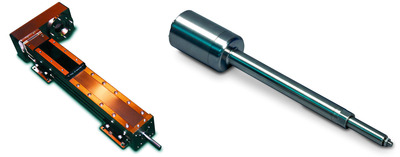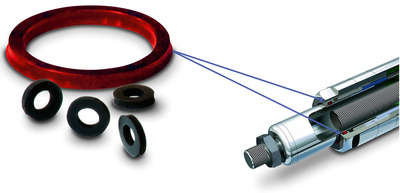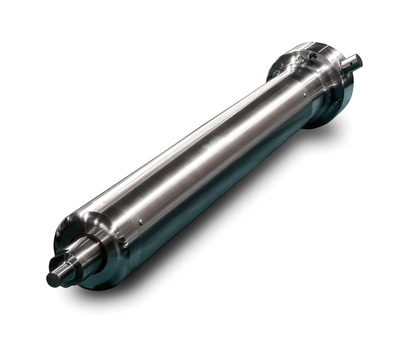Evaluating actuators for food and beverage applications
Production of food and beverages on today’s industrial scale would not be possible without a high level of automation. Pneumatic, hydraulic and electric actuators are critical moving components in equipment used for processing and packaging food and beverage products for world markets. In addition to efficient production, machines used to process food must keep food safe by not harbouring or introducing bacteria, lubricating fluids or other contaminants that could harm consumers. That is why actuators used in the food and beverage industry must be manufactured from appropriate materials and designed in a way that eliminates collection points where bacteria can flourish. Suitable actuators must also be capable of withstanding frequent washdown with water, detergents, steam, caustic soda, citric acid or other types of sanitary cleaning solutions.
There are certain ways in which actuators need to be designed and built in order to perform in this challenging environment - and process and automation engineers therefore need to select the most appropriate actuators for their food and beverage applications.
The food and beverage environment
The most critical food and beverage processing applications involve dairy, meat and egg processing; and there are government authorities that are charged with regulating sanitary conditions in these facilities. However, many other types of facilities involved in food and beverage processing do not fall under government jurisdiction and yet they tend to follow the general guidelines for safe equipment selection and operation. These types of facilities include large bakeries, food packaging operations and many different types of bottling plants.
Machinery used in food and beverage processing may use several types of actuators, including rod-style, rodless or rotary depending on where they are located in the processing equipment and how they are shielded from washdown processes. The bearing system of a rodless actuator is designed to carry loads throughout the actuator’s stroke and cannot be sealed adequately to prevent the ingress of liquids into the actuator’s internal components and needs to be well shielded from the washdown process. For applications that require the actuator to come in direct contact with washdown solutions, the rod-style actuator is the only choice due to its sealing characteristics. Pneumatic rod-style actuators are still widely used in the food and beverage industry due to their low cost points, but electric rod-style actuators are gaining momentum for a variety of reasons including flexibility of control (multiple positions and motion profiles), efficiency (elimination of compressed air) and higher performance (precision, accuracy, repeatability).

While the working parts of a typical rod-style actuator may not ever come in direct contact with the food product or its packaging, there are invariably spills, drips and spatters that collect on various parts of the processing machinery, including the actuators. Unless this residue is removed from the equipment on a regular basis, it can become a reservoir of dust, bacteria, fungi and other spoilage organisms that may contaminate the food product or packaging.
Materials suitable for washdown environments
Actuators used in washdown environments either have to be properly sealed and made of corrosion-resistant materials or be carefully shielded to prevent water, food products or chemicals from reaching the actuator mechanism. While shielding of more economical actuators not designed for washdown is widely practised, shields complicate equipment design and many times interfere with maintenance. Moreover, the recent emergence of catalogue-listed stainless steel rod-style electric actuators designed for washdown will likely reduce the popularity of shielding as a money-saving strategy.
Actuators intended for washdown environments need to be made of corrosion-resistant metals, and other parts such as seals, connectors and lubricating fluids need to be compatible with food processing as well. Ideally, actuators used in washdown environments should be constructed of AISI 300 series stainless steel (excluding type 301 and 302), with 304 and 316 being the most popular.

Aluminium alloy as an actuator construction material may be satisfactory for some dry product processing applications as long as it is not subjected to strong caustic cleaning solutions or to the corrosive action of dissimilar metals. While metal alloys other than stainless steel or aluminium may be suitable under certain conditions, alloys containing lead, leachable copper or other toxic metals must be avoided in food and beverage applications. Certain surface treatments or coatings may be used to reduce corrosion on components that have product contact, but the coatings need to be approved for food and beverage use.
Plastic or rubber parts on actuators, such as seals, gaskets or accessories, need to be suitable for food and beverage applications if they are in contact with the product. In addition, these seals, gaskets and accessories must be capable of withstanding the effects of the cleaning solutions used.
While there exists a list of approved plastic and rubber materials, some of the most popular of the approved products are Viton O-rings and seals and ultrahigh molecular weight (UHMW) polyethylene for some mechanical parts.

Lubricants used on actuator rods that may be subject to incidental food spatters or contact need to be food-grade oils and greases as approved by the FDA. Proper seals between the actuator body and the rod on an IP67- or IP69K-rated product typically keep lubricant exposure to a minimum.
Design and fabrication
The design of electric rod-style actuators for food and beverage applications needs to be free of crevices that may harbour bacteria, be sealed for washdown and have rounded surfaces with a smooth finish that sheds moisture. Motor housings, actuator bodies, corners and edges should be rounded to promote moisture runoff. Generally, a number 4 ground finish on stainless steel that is free of pits, cracks, folds or other imperfections is suitable for washdown applications. For welded junctions, electropolishing, glass beading and shot peening are not generally acceptable alternatives to a number 4 ground finish.
Permanent joints in the construction of an actuator, such as where the motor housing joins the screw barrel, may be either welded or gasketed, but any junction should be fully cleanable when assembled. Where two parts meet with a gasket, it is important to make sure the adjacent surfaces and the gasket are flush. If the gasket either protrudes or is recessed, it can form crevices that may collect moisture, food debris and bacteria. In cases where the actuator is assembled with O-rings instead of gaskets, make sure the O-ring completely fills the gap between the two mating parts. Actuators with grooves along the screw body to accept position switches would not be suitable for use in a food and beverage application.
Fasteners used on actuators intended for washdown environments also need to be able to shed water freely. Avoid socket-head bolts, counter-bored holes, slotted screws or fasteners with knurling, as they all have debris collection points. Hex-head bolts or dome nuts are the preferred alternative. Make sure the actuator has no fasteners with exposed threads where debris can collect.
Whether an actuator is pneumatic, hydraulic or electric, it must be sealed properly so that dust, drips and washdown solutions do not contaminate the motor or internal mechanisms. Actuators with an IP65 or IP67 rating are protected against ingress of dust and high-pressure washdown under static conditions. For extreme washdown environments, an IP69K rating offers the best protection.

While the IP69K rating is not synonymous with protection from chemical attack due to aggressive cleaning solutions, this rating does maintain a high level of ingress protection in high-pressure spray situations. It is therefore important to have an understanding of both the cleaning solutions intended to be used as well as the sealing elements employed in the actuator device to ensure compatibility.
Actuator maintenance
Maintenance of food processing or packaging equipment is vital for proper sanitation and maximum uptime. The washdown environment is hard on equipment, and it is important to be constantly looking for any evidence of corrosion or less than optimum operation. Actuators, when specifically designed for washdown environments and properly sized for the application, can be very durable components. However, it is important to periodically inspect actuators for any signs of seal wear along the rod, loose components, pitting or corrosion. Pitting or corrosion can create sites that collect moisture and also harbour debris or bacteria.
Conclusion
Actuators play an important role in processing and packaging machinery used in the food and beverage industry, where they must withstand frequent washdown. The design of actuators used in these applications is critical to the health and safety of the products being produced. The materials from which they are fabricated must resist corrosion and cleaning solutions, while not leaching toxic substances into the food products or packaging. Manufacturing engineers who select actuators that are designed for washdown and food and beverage applications will find that they are much easier to integrate into an application than actuators that need sanitary barriers or other types of shielding. With the emergence of catalogue stainless steel electric rod-style actuators, engineers now have an economical way to incorporate electric actuators into food and beverage applications. By consulting with their actuator distributor or manufacturer early in the design phase of an application, engineers can ensure the most efficient, economical and safe food and beverage application.
Is smart manufacturing moving fast enough?
Manufacturers that embrace smart manufacturing can use those technologies to create a competitive...
ABB identifies new frontiers for robotics and AI in 2024
Accelerating progress in AI is redefining what is possible with industrial robotics.
The need for speed
The constant improvements by CPU manufacturers are providing new processing techniques that...














